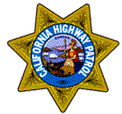

CHP RADIO SYSTEMS
PART 2
1962-1977
THE 1963 MOBILE RADIO FLEET
In 1963, large contracts were completed to purchase an entirely new radio fleet for the CHP's patrol cars, from both RCA and Motorola, for a special radio which would be unique to the CHP. A major change for 1963 was that the state was broken up into regions with different dispatch channels in each. Previously, the entire fleet, statewide, had all been dispatched on a single frequency! There were now three channels, Blue, Red and Green, and in the following years many additional color coded channels were added. The system of color coding the channels was created by CHP's communications engineer Jim Angliss and Motorola sales engineer William Lieske, Sr..
These 1963 radios were the first to use a "four-channel" arrangement, and were a creation of a committee which included Motorola's Lieske, top CHP staff, and State of California communications engineers Jim Angliss and Stu Nashke. Lieske then presented the plan to Motorola in Chicago, which created the specially modified radios to meet the necessary requirements. Presumably the RCA sales team did the same with their radio design.
The 1963 radios were also the first ones making extensive use of transistors, and the control heads were custom designed to CHP specifications. The frequency selection was to be marked with four labels, namely "S-C-S-C". "S" refers to "station", while "C" refers to "car to car." The left-most S-C labels refer to station or car-to-car operation on the first channel, while the right-most pair of S-C marks refers to station or car-to-car operation on the second channel. The second channel in all radios, regardless of location, was the original statewide "Blue" frequency of 42.34 MHz. The first channel was whatever frequency was in use in the area of operation of that particular patrol car.
Note that the "S" and "C" channel designations are very confusing if you have a background in radio. Basically, think of the channel the car is transmitting on and not the station. The "S" configuration means the channel the cars talk to the station on. The "C" channel is the car to car frequency, in other words the cars talk on the same frequency as the station. The car receiver is always on the dispatch frequency.
Control heads were marked with a removable paper color dot above the left-most S-C pair of labels; this refers to the CHP color coding system for radio channels. The right-most color dot was always Blue, the statewide channel. There was a tone-burst switch with 5 tones available; this switch is next to the channel selector and when placed in any of the five positions, would cause a short audible beep-tone to be transmitted whenever the pushbutton on the microphone was depressed, before the officer began speaking. The tone burst was used to activate remote mountaintop receivers in some areas, but generally was not used except when a unit traveled to another division and wanted to talk to the dispatcher in that division, which usually required selecting either Tone 1 or Tone 5. It appears that Tones 2-4 were not used.
The "PL" tone switch activated a sub-audible tone squelch circuit, such that only signals from the proper CHP radio transmitters would be heard. This eliminated static from power lines and other interference from being heard in the patrol car's radio during idle periods and also prevented hearing the occasional "skip" transmissions from distant non-CHP state police transmitters, and to a limited extent offered the opportunity to re-use the same channels within the state. As a practical matter, the "PL" function seems to have been little used in the cars and officers from the late 1960's report having regularly heard "skip" signals from eastern police agencies during the excellent sunspot cycle years of 1968-73.
MOTOROLA 1963 RADIOS:
The 1963 Motorola radio was a specially produced Motrac model radio, type X51HHT-3190A. It was a two channel receive, four channel radio without a noise blanker ("extender") but with "PL" (a single "Private Line" CTCSS sub audible tone). The radio drawer is a special extended-case model to allow for the extra two transmitter channels, and thus these radios can be recognized by the longer case. Motorola sold approximately 2000 of these to the CHP in 1963. The control head is a special model made for the CHP (see photo below). Note that it does NOT say "California Highway Patrol" on it, just "State of California." The basic layout of this sheet metal control head had already been used some years earlier to supply numerous state and regional customers, such as the Los Angeles County Flood Control District, California Department of Forestry, and others. Only the faceplate needed to be custom-engraved.
RCA 1963 RADIOS:
For some reason Motorola did not receive the entire contract for new radios in 1963; at least half of it went to RCA. The 1963 RCA radio was a specially produced "Super Carfone" model radio, type CMFA-50-X-MBR4020S. It was identical in features to the Motrac radio supplied by Motorola. The control head was also a special model made for the CHP, and looks almost identical to the Motorola, although the two are quite different electrically and can not interchange. The RCA control head contains the audio amplifier transistors, while the Motorola radio has all active circuitry contained within the radio itself (see photos below). An interesting feature of the RCA radio is that it used instant heating tubes in the transmitter, with a filament switch wired to the microphone hang-up box, so that upon lifting the microphone from its hang-up box, the tubes would be lit and ready to use in less than one second. This significantly reduced battery drain compared to the Motorola competitive product, but the officer needed to remember to replace the microphone on its hang-up box when finished. The unpopular 1951 "Avia" CHP motorcycle radios used this same feature. The transmitter in the RCA radio used fewer tubes than the Motorola product, as it had more transistorized stages, however the RCA equipment was generally considered of cheaper design. It is unknown at this time how many RCA units the CHP purchased, other than the presumption that at least 2000 were ordered to allow the special production control head and radio modifications to be made economically.
In 1966, the CHP added fully transistorized versions of both of these radios to the fleet, in the process retiring any remaining pre-1963 vintage equipment.
The photo below shows the two versions of the RCA hand microphones supplied with the CHP contract equipment.
MOTOROLA 1966 RADIOS:
The new 1966 contract Motorola radio was the "Motran" model, type X51LLT-3490A. Also a custom made radio, it featured a noise blanker (finally) and was fully transistorized with no moving parts. The control head was changed in that a switch marked "Extend" was added (noise blanker) and a circuit was added to dim the pilot lamps automatically depending on ambient light inside the patrol car (a small photocell behind a window on the front panel senses interior light conditions). The 1966 control head is the first Motorola head to actually be engraved "California Highway Patrol" on the front panel, unlike the RCA, which used this logo in 1963. The Motran was supplied with two different "PL" tones, the first being automatically selected for the two "S" channels and the other one being automatically selected for the two "C" channels. Evidently the CHP specified this dual PL requirement to Motorola but later changed its mind, as the State of California radio shops wired jumpers into all the radios I have seen, such that only one PL tone was possible. The Motran radios were shipped to CHP from mid 1966 through 1968 but supplemented, rather than replaced, existing equipment. Most of the Motran radios were used in southern California, while northern areas seem to have mainly used the RCA radios.
RCA 1966 RADIOS:
The 1966 contract RCA radio was their fully transistorized "Super Fleetfone" model, otherwise identical in appearance to the 1963 radio but intended to compete with and meet the specifications of the Motorola Motran. It is model CMFB5-A-MBP9085D. The control head is identical to the 1963 version, except for the addition of an "extender" switch in the lower left corner. The RCA version of the pilot lamp dimmer is just a manually adjustable military style dimmer lens on each lamp, in other words a cheaper design. The RCA radios were shipped to CHP throughout 1967-68. Interestingly, all RCA 1963 and 1966 radios were seen in original service using the Motorola speakers from the previous radio fleet, or speakers concealed in the vehicle dash, rather than the low-profile RCA speaker. Evidently the CHP tried to economize by re-using the old Motorola speakers, or possibly RCA was unable to supply a speaker which met CHP standards (the RCA speaker is indeed a poor performer compared to the Motorola). Anyone with further information on this strange situation, please contact me ! As with the Motorola equipment above, the 1966 contract RCA equipment supplemented, rather than replaced, the 1963 equipment already in service.
The photo below shows the interior of a new 1969 Dodge Polara, just after installation of the radio and emergency equipment. Note the use of a Motorola speaker with an RCA 1963 contract "Super Carfone" radio ! (Thanks to Ron Hurwitz and Tom Yeager for this photo)
Note that the silk-screened OFF-VOLUME letters have been completely worn off on the above head!
Here's another rare photo of the RCA Super Carfone equipment, in use in a 1970 Mercury patrol car in the early 1970's. Note that the shop has replaced a broken or lost squelch knob with one from the Motorola Motran control head! Also note that this is the 1963 Super Carfone equipment rather than the 1966 Super Fleetfone, because there is no "Extender" switch as seen on the control head in the above photo. The map light above the dash is by Roxter, a manufacturer still in business today. The RCA equipment required a microphone "hang up box" which was wired back to the control head and which turned the "instant heating" tubes in the transmitter on when the microphone was taken off the box. This was a battery saving feature not adopted by Motorola on the competing Motrac CHP radio, where the transmitter tube filaments were always lit. It's not clear in the photo but there should be a cable running from the microphone hang-up box assembly to the radio control head on the Super Carfone radio model.
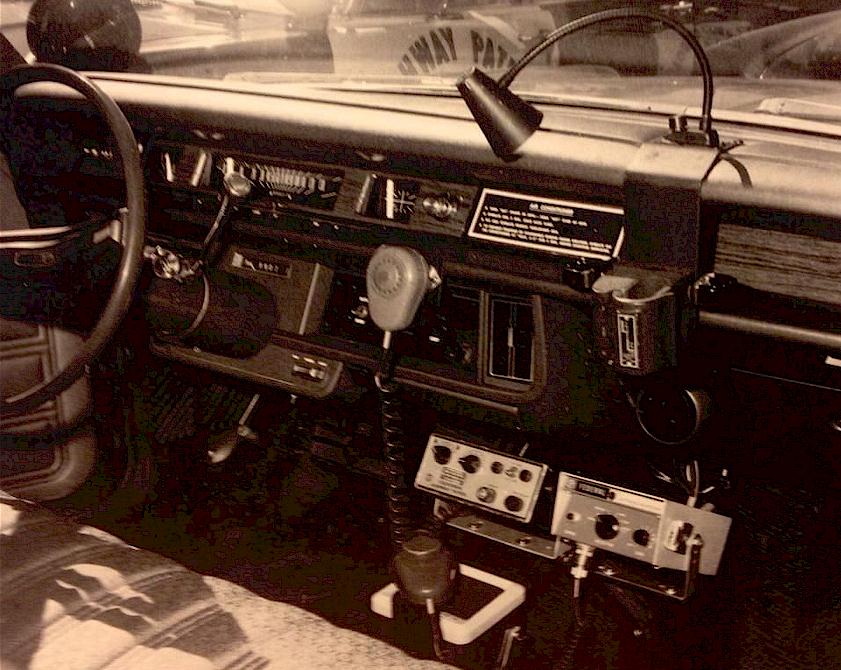
CHP MOTOR TRANSPORT WIRING DIAGRAM FOR 1968 AND 1969 DODGES AS ABOVE:
CLICK HERE FOR PDF OF DOCUMENT
SPECIAL EQUIPMENT:
A number of specially made radios were used, primarily in supervisor vehicles and special service applications. Some of these were one-of-a-kind and little is known about them. One of the special radios made in some quantity was the "5 and 9", a 13 channel CHP administrator's vehicle Motrac radio (circa 1964) which had 5 receive and 9 transmit channels, compared to the 2 receive and 4 transmit channels of the regular Motrac. The "5 and 9" consisted of two (!) large Motrac mobile radio drawers patched together (!) with a short "Siamese" cable. The control head was similar to the standard Motrac head, except that the channel selector had more positions and smaller print. The second radio drawer did not contain a receiver, it only contained an additional transmitter section. These radios were sold to CHP by Motorola's William Lieske, Sr., in what is presumed to have been a small quantity, which is interesting since the tooling and design work to create them must have been substantial. None are known to have survived, although it is possible, since several of these control heads were seen at electronics flea markets in the 1990's. These radios were rare enough that the service manuals were required to be kept in the vehicle with the radios at all times! It is not known if any of these special radios were ever made by RCA or in a Motorola Motran version.
The "5 and 9" control head is shown below:
DUAL ANTENNA CARS:
During the 1973-1978 period (more or less) a number of patrol cars were equipped with dual low band whip antennas of the "ball and spring" type. Most of these were from the Central LA Office. At that time Central LA was using the "Black" frequency set, which was unusual in that it was 45.02 / 44.68 . Neither the Motorola Motrac-Motran nor the RCA Super Carfone - Super Fleetfone equipment still in use was capable of spreading that far from the primary channel tuning of the "Blue" frequency. Thus to do this it was necessary to fit two radios in any car that was using the Black frequency - - one for the Blue channel and the other the Black. This also allowed a different area frequency to be used by the second channel of the radio tuned to the Blue frequency. Sometime around 1978, the Black frequency was reassigned to 42.46 / 42.70 and the need for a second radio ended. Additionally, the replacement Micor radios of 1977 had dual receivers and were capable of operating on the Black and the Blue frequencies without issues, unlike the preceding equipment.
In the San Francisco Bay area, the Sierras and some of the border areas, there were some dual antenna cars as well. One reason given is that the nature of the antenna mounted on the rear "cowl" area behind the rear window is that the antenna pattern is somewhat directional and favors a certain radiation pattern rather than being omni directional as a roof mounted antenna would be. This means that depending upon which direction the car was pointed in, the radio signal could be good or poor. In the case of the dual antenna cars, they may have been used where coverage was less than optimum, to enhance radio operation. The radiation pattern from the car (and received by it) was improved by using two antennas and became more omni-directional. There was a coupling harness consisting of matched sections of coaxial cable and a "T" connector feeding each antenna. This system seems to have been discontinued at least by 1979, as the older Motrac, Motran and RCA radios had been fully removed from service by then and been replaced by the Micor Motorola radios. The Micor radios, in addition to having over 100 Watts output (twice the power of the old radios,) had more sensitive receivers and better noise blankers, (the Motrac and RCA Super-Carfone radios had no noise blankers at all!) which must have eliminated the need for dual antennas. If you have information about all the uses of the dual antennas, let me know and I can add it here,
There were also a few cars equipped with second radios for additional channels, which used the second low band antenna.
MECHANICAL SIRENS:
These web pages started out as just a summary of the radio equipment, but I get so many inquiries about the emergency lighting and sirens that I have tried to add what information I know about those as well. CHP patrol cars were still equipped with electro-mechanical sirens through at least 1970, and evidently after that on an unclear level as well. From the time the CHP vehicles were standardized to 12 Volts (12 Volts became standard on all American cars by 1956) the typical siren used was the Federal Signal Model C4B. This siren is a coaster-brake style siren, meaning that there is a brake release wire required as well as the main power. The C4 is a painted siren for under hood mounting and has no rear outer housing. In order to fit, many (most?) were mounted left to right in the area behind the grille in front of the radiator support panels. Anecdotal evidence suggests that B&M sirens as well as Federal Model 28's (a non-coaster-brake style) were also used.
A blow-up of a 1968-69 switch panel with my Photoshop text of what the lettering should say on the switches, is shown here:
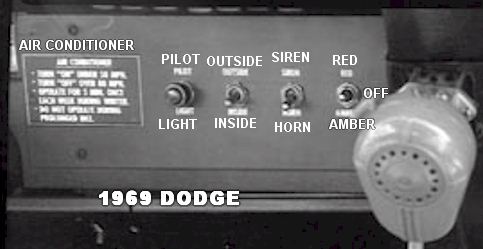
The lettering about the air conditioner has to do with what speeds it should be "on" and "off" at and something about avoiding prolonged idling with it on and to run it briefly during the winter. If you need the exact air conditioning wording on this plate, let me know and I'll see if I can zoom from a better original.
The pilot lamp alerts the officer that one of the switches is not in the normal position.
ELECTRONIC SIRENS:
In approximately 1966, electronic sirens began to be added to the patrol cars on a test basis, by various manufacturers including Federal Signal. By 1967, electronic sirens became standard equipment in addition to the previous mechanical ones. The initial shipment was supplied by Federal Signal to CHP specifications and did not feature the yelp or riot modes, nor was the radio rebroadcast feature wired in. These first electronic sirens were similar to the Interceptor model but pre-date it. (More information is welcomed !) A Federal Signal Interceptor PA-20 Siren/PA unit was installed in almost all cars in 1968, which was wired to a separate PA style speaker under the hood, unrelated to the "radio outside" speaker, and with the riot and "yelp" functions disabled.
The siren speaker was added to the under-hood area behind the vehicle grille. There were then two speakers under the hood; 1) the "outside" speaker for the two way radio, and 2) the speaker for the Federal Interceptor. The CHP did not use the "radio rebroadcast" feature available on the Federal PA-20A. With some exceptions, the mechanical siren under the hood remained at least into the early 1970's, this comment being based on the 1969 wiring diagrams for the Dodge vehicles from CHP Motor Transport which show both the electronic and mechanical sirens in place, and from interviews with retired officers.
NOTE: ALL OF THE 1963-66 RADIOS WERE IN SERVICE SIMULTANEOUSLY UNTIL 1977, WHEN THEY WERE ENTIRELY REMOVED FROM SERVICE AS THE VEHICLES THEMSELVES WERE RETIRED. THIS PROCESS TOOK SEVERAL YEARS TO ACCOMPLISH BECAUSE OF THE SIZE OF THE VEHICLE FLEET.
The photos below were taken in late summer 1969 of the under-hood area of a Dodge CHP station wagon in the Sacramento area. The speaker shown is an experimental siren-PA speaker branded "Fyr-Fiter" which was used on approximately 50 Dodge Polara cars in this time frame on an experimental basis (thanks to Ron Hurwitz for this information!) The "radio-outside" speaker is not visible, nor is a mechanical siren if one was installed. Photos of the interiors of cars in service, as well as those of under-hood and trunk interior views, are very rare today. If you have any to share, please send them!
Photos courtesy Dale Poppleton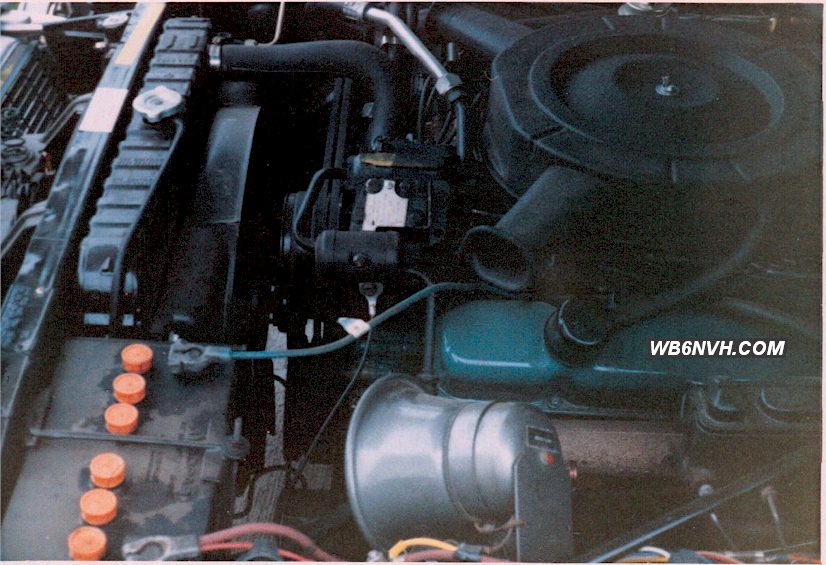
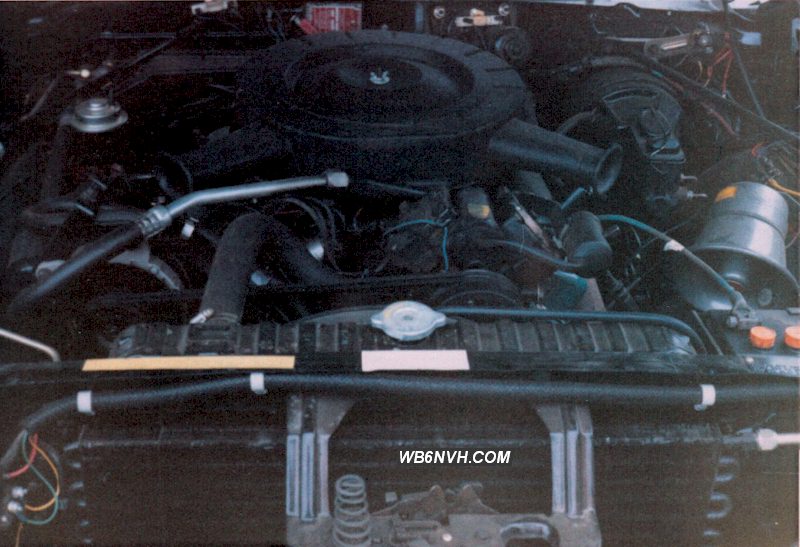
CLICK HERE TO SEE MORE PHOTOS OF THE CAR ABOVE
SPECIAL TEST EQUIPMENT
The item below is a special service control head made by the State of California General Services Dept. for use by radio shops that serviced the CHP mobile radio equipment, and seems to be called a D/E 101 .. This was for operating a radio from the vehicle trunk while testing it. The way this works is that the cable coming into the trunk from the radio head and battery is plugged into this box. Then the box is plugged into the radio, using the appropriate adapter cable, and it allows channel changing, volume and squelch adjustment and some other features. What comes to mind is the question of why this was needed, compared to just removing the radio and testing it indoors in a well lit and heated shop! This box could check any of the CHP radios in use in the 1960's, from the last GE Progress Lines to the Motorola and RCA hybrid and solid state gear, including the rare "5 & 9" two piece Motrac supervisor radios mentioned earlier. It is unknown whether there was a similar box made for the Micor radio fleet of 1977.
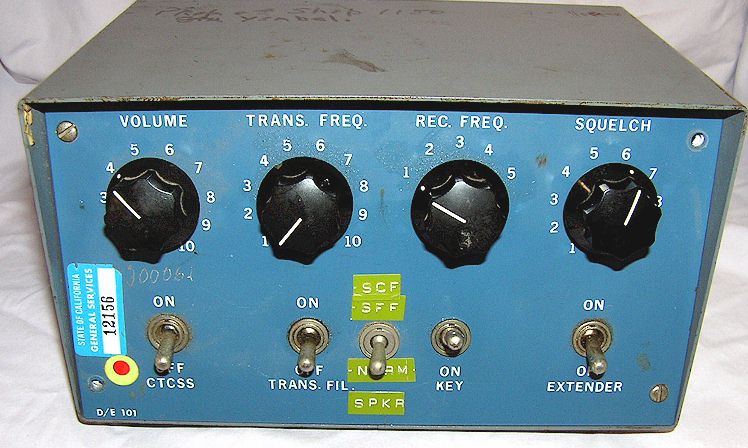
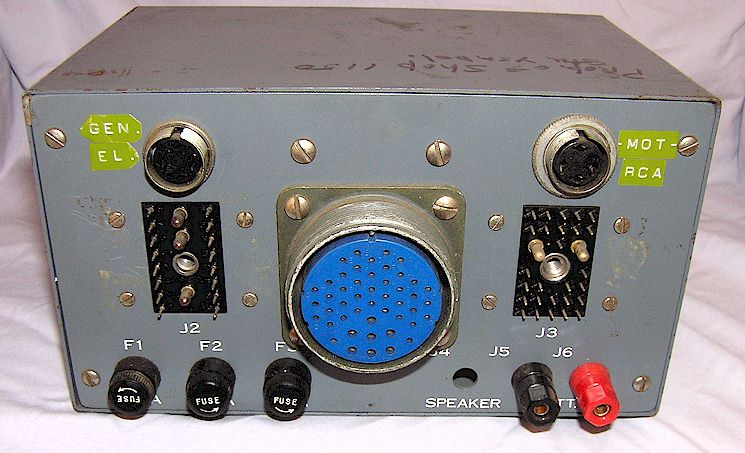
THE FATE OF THE 1963-66 RADIO FLEET
Throughout 1977, the CHP began replacement of all radios in its mobile fleet, after purchasing a new model from Motorola as described below. This was the first time that all previous equipment was surplused and a single manufacturer and model of equipment purchased to replace it, and the last time CHP would buy equipment from Motorola. All old equipment was traded-in to Motorola, and Motorola destroyed all of the RCA CHP radios as "foreign equipment". Motorola did not attempt to refurbish or sell any of the Motorola branded CHP trade-in equipment either, however a few Motorola employees came up with a plan to sell the radios, as-is and without accessories, to radio amateurs (who were required to sign a waiver that they would never re-sell the radios back to commercial users.) The radios were sold for $ 50 each, plus shipping, primarily from Hank Arnold at Motorola's Foster City, California used equipment office, throughout 1978. Apparently the El Segundo, California office also briefly participated in this arrangement. When I acquired some at that time, there were no control heads or cables available, although these later showed up at electronics flea markets throughout California. At the time, the best radio available through this surplus program was the CHP Motran, and that was primarily what Motorola offered to amateurs, although the earlier CHP Motrac was also available for the same price. It is doubtful that more than a handful of the Motracs, if any, were sold to amateurs, so they are very rare today. Because all of the RCA equipment was destroyed by Motorola, it is extinct, although a few units survived because they were spares still sitting on state radio shop shelves during the trade-in period, or were saved by radio technicians as "souvenirs".
Please note that there is incorrect information on the CHP's official website regarding this, where it states that in 1977 "Motorola took over the radio contract from GE." Prior to 1977, both Motorola and RCA supplied mobile radios to CHP, not GE. At that time, GE had not received business from the CHP since 1950 other than a modest order of various Progress Line mobiles in the late 1950's. GE would not receive further business from CHP until 1988.
Ver. 0/13/2020 © Geoffrey C. Fors 1998 All rights reserved